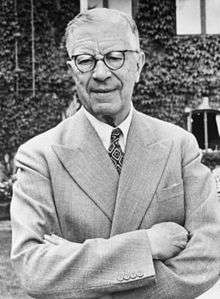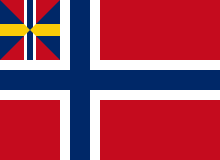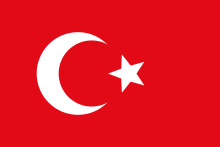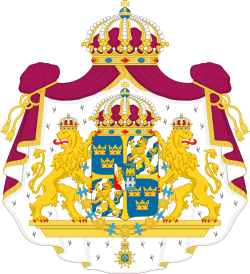Gustaf VI Adolf
Gustaf VI Adolf (Oscar Fredrik Wilhelm Olaf Gustaf Adolf; 11 November 1882 – 15 September 1973) was King of Sweden from 29 October 1950 until his death. He was the eldest son of King Gustaf V and his wife, Victoria of Baden, and had been Crown Prince of Sweden for the preceding 43 years in the reign of his father. Not long before his death at age 90, he approved the constitutional changes which removed the Swedish monarchy's last nominal political powers. He was a lifelong amateur archeologist particularly interested in Ancient Italian cultures.
| Gustaf VI Adolf | |||||
|---|---|---|---|---|---|
 King Gustaf VI Adolf in 1962 | |||||
| King of Sweden | |||||
| Reign | 29 October 1950 – 15 September 1973 | ||||
| Predecessor | Gustaf V | ||||
| Successor | Carl XVI Gustaf | ||||
| Prime Ministers | See list
| ||||
| Born | 11 November 1882 Stockholm Palace, Stockholm, Sweden | ||||
| Died | 15 September 1973 (aged 90) Helsingborg Hospital, Helsingborg, Sweden | ||||
| Burial | 25 September 1973 | ||||
| Spouse | Lady Louise Mountbatten (m. 1923; died 1965) | ||||
| Issue | Prince Gustaf Adolf, Duke of Västerbotten Sigvard Bernadotte Ingrid, Queen of Denmark Prince Bertil, Duke of Halland Carl Johan Bernadotte | ||||
| |||||
| House | Bernadotte | ||||
| Father | Gustaf V of Sweden | ||||
| Mother | Victoria of Baden | ||||
| Religion | Church of Sweden | ||||
Birth
He was born at the Royal Palace in Stockholm and at birth created Duke of Scania. A patrilineal member of the Bernadotte family, he was also a descendant of the House of Vasa through maternal lines. Through his mother, Victoria, he was a descendant of Gustav IV Adolf of Sweden of the deposed House of Holstein-Gottorp.
Crown Prince (1907–1950)
Gustaf Adolf became Crown Prince of Sweden on 8 December 1907, on the death of his grandfather, King Oscar II.
In 1938 he was elected an honorary member of the Virginia Society of the Cincinnati.
Reign (1950–1973)
On 29 October 1950, Crown Prince Gustaf Adolf became king a few days before his 68th birthday, upon the death of his father, King Gustaf V. He was at the time the world's oldest heir apparent to a monarchy (this in turn was broken by his great-nephew Charles, Prince of Wales on 2 November 2016). His personal motto was Plikten framför allt, "Duty before all".
During Gustaf VI Adolf's reign, work was underway on a new Instrument of Government to replace the 1809 constitution and produce reforms consistent with the times. Among the reforms sought by some Swedes was the replacement of the monarchy or at least some moderation of the old constitution's provision that "The King alone shall govern the realm."
Gustaf VI Adolf's personal qualities made him popular among the Swedish people and, in turn, this popularity led to strong public opinion in favour of the retention of the monarchy. Gustaf VI Adolf's expertise and interest in a wide range of fields (architecture and botany being but two) made him respected, as did his informal and modest nature and his purposeful avoidance of pomp. While the monarchy had been de facto subordinate to the Riksdag and ministers since the definitive establishment of parliamentary rule in 1917, the king still nominally retained considerable reserve powers. With few exceptions, though, Gustaf was bound to act on the advice of the ministers. These nominal powers were removed when Sweden's constitutional reform became complete in 1975, thus making Gustaf Adolf the last monarch to wield even nominal political power.
The King died in 1973, ten weeks shy of his 91st birthday, at the old hospital in Helsingborg, Scania, close to his summer residence, Sofiero Castle, after a deterioration in his health that culminated in pneumonia. He was succeeded on the throne by his 27-year-old grandson Carl XVI Gustaf, son of the late Prince Gustaf Adolf. He died the day before the election of 1973, which is suggested to have swayed it in support of the incumbent Social Democratic government.[1] In a break with tradition, he was not buried in Riddarholmskyrkan in Stockholm, but in the Royal Cemetery in Haga alongside his wives. He was the last surviving son of Gustaf V.
Personal interests

The King's reputation as a "professional amateur professor" was widely known; nationally and internationally, and among his relatives. Gustaf VI Adolf was a devoted archaeologist, and was admitted to the British Academy for his work in botany in 1958. Gustaf VI Adolf participated in archaeological expeditions in China, Greece, Korea and Italy, and founded the Swedish Institute in Rome.
Gustaf VI Adolf had an enormous private library consisting of 80 000 volumes and – nearly more impressively – he actually had read the main part of the books. He had an interest in specialist literature on Chinese art and East Asian history. Throughout his life, King Gustaf VI Adolf was particularly interested in the history of civilization, and he participated in several archaeological expeditions. His other great area of interest was botany, concentrating in flowers and gardening. He was considered an expert on the Rhododendron flower. At Sofiero Castle (the king's summer residence) he created one of the very finest Rhododendron collections.
Like his sons, Prince Gustaf Adolf and Prince Bertil, Gustaf VI Adolf maintained wide, lifelong interests in sports. He enjoyed tennis and golf, and fly fishing for charity. He was president of the Swedish Olympic Committee and the Swedish Sports Confederation from their foundations and until 1933, and these positions were then taken over by his sons in succession, Gustaf Adolf until 1947 and then Bertil until 1997.
According to all six books of memoires by his sons Sigvard[2] and Carl Johan,[3] nephew Lennart[4] and of wives of the two sons,[5] Gustaf Adolf from the 1930s on took a great and abiding interest in removing their royal titles and privileges (because of marriages that were unconstitutional at the time), persuaded his father Gustaf V to do so and to have the Royal Court call the three family members only Mr. Bernadotte.
Family and issue
_Adolf_of_Sweden_w_fam_07729v.jpg)
Gustaf Adolf married Princess Margaret of Connaught on 15 June 1905 in St. George's Chapel, at Windsor Castle. Princess Margaret was the daughter of Prince Arthur, Duke of Connaught, third son of Queen Victoria and Prince Albert of the United Kingdom. Gustaf Adolf and Margaret had five children:
| Name | Birth | Death | Notes |
|---|---|---|---|
| Prince Gustaf Adolf, Duke of Västerbotten | 22 April 1906 | 26 January 1947 (aged 40) | Married Princess Sibylla of Saxe-Coburg and Gotha, his second cousin; died in a plane crash at Copenhagen Airport, father of King Carl XVI Gustaf of Sweden |
| Prince Sigvard, Duke of Uppland | 7 June 1907 | 4 February 2002 (aged 94) | later Sigvard Count of Wisborg |
| Princess Ingrid | 28 March 1910 | 7 November 2000 (aged 90) | later Queen of Denmark; wife of Frederick IX of Denmark and mother of the present Queen Margrethe II of Denmark and Queen Anne-Marie of Greece |
| Prince Bertil, Duke of Halland | 28 February 1912 | 5 January 1997 (aged 84) | married Lillian Davies, no issue |
| Prince Carl Johan, Duke of Dalarna | 31 October 1916 | 5 May 2012 (aged 95) | later Carl Johan Count of Wisborg. |
Crown Princess Margaret died suddenly on 1 May 1920 with her cause of death given as an infection following surgery. At the time, she was eight months pregnant and expecting their sixth child.
Gustaf Adolf married Lady Louise Mountbatten, formerly Princess Louise of Battenberg, on 3 November 1923 at St. James's Palace.[6] She was the sister of Lord Mountbatten and aunt of Prince Philip, Duke of Edinburgh. It was Lady Louise who became Queen of Sweden. Both Queen Louise and her stepchildren were great-grandchildren of Queen Victoria of the United Kingdom.
His second marriage produced only one stillborn daughter on 30 May 1925.
While his first wife visited her native Britain in the early years of their marriage, it was widely rumored in Sweden that Gustaf Adolf had an affair there with operetta star Rosa Grünberg.[7] Swedish vocalist Carl E. Olivebring (1919–2002) in a press interview claimed to be an extramarital son of Gustaf VI Adolf, a claim taken seriously by the king's biographer Kjell Fridh (1944–1998).[8]
King Gustaf VI Adolf of Sweden was the grandfather of his direct successor King Carl XVI Gustaf of Sweden, of Queen Margrethe II of Denmark and also of former Queen Anne-Marie of Greece.
King Gustaf VI Adolf of Sweden was the uncle by his second marriage to the Duke of Edinburgh.
Honours
Swedish
| Country | Date | Appointment | |
|---|---|---|---|
| 11 November 1882 – 19 October 1950 | Knight with Collar | Royal Order of the Seraphim | |
| 11 November 1882 – 19 October 1950 | Commander Grand Cross | Order of the Sword | |
| 11 November 1882 – 19 October 1950 | Commander Grand Cross | Order of the Polar Star | |
| 1 June 1912 – 19 October 1950 | Commander Grand Cross | Order of Vasa | |
| 11 November 1882 – 19 October 1950 | Knight with Collar | Order of Charles XIII | |
| 18 September 1897 | King Oscar II's Jubilee Commemorative Medal | ||
| 20 September 1906 | Crown Prince Gustaf's and Crown Princess Victoria's Silver Wedding Medal | ||
| 6 June 1907 | King Oscar II and Queen Sofia's Golden Wedding Medal | ||
| 16 June 1928 | King Gustaf V's Jubilee Commemorative Medal | ||
| 16 June 1948 | King Gustaf V's Jubilee Commemorative Medal | ||
- Quasi-Official Orders
- High Protector (and Honorary Knight) of the Order of St John in Sweden
- The Medal Illis Quorum Meruere Labores of the 18th size
Foreign

- Grand Cross of St. Olav, with Collar, 11 November 1882[10]
- Knight of the Norwegian Lion, 21 January 1904[11]
- Austria:
.svg.png)

.svg.png)


- Knight of the Elephant, 28 October 1903
- Cross of Honour of the Order of the Dannebrog, 31 May 1935
- King Christian X's Liberty Medal
- Grand Commander of the Dannebrog, 24 March 1952

.svg.png)
.svg.png)

.svg.png)
- Germany:
.svg.png)

.svg.png)
.svg.png)
.svg.png)
- Italy:
_crowned.svg.png)

.svg.png)



.svg.png)


- Knight of St. Andrew
- Knight of St. Alexander Nevsky
- Knight of St. Stanislaus, 1st Class
- Knight of St. Anna, 1st Class
- Knight of the White Eagle
.svg.png)
.svg.png)

- Honorary Grand Cross of the Royal Victorian Order, 12 May 1905[18]
- Honorary Grand Cross of the Bath (civil), 14 June 1905[19]
- Royal Victorian Chain, 1923[20]
- Stranger Knight of the Garter, 28 June 1954[21]
- Honorary degrees

In 1918, Gustaf VI Adolf received an honorary doctorate at Lund University, in 1926 an Honorary Doctorate at Yale, Princeton and Clark Universities, at Cambridge in 1929 and in 1932 at the University of Dorpat.
Honorary military ranks
- Royal Air Force Air Chief Marshal 15 September 1959 [22]
- Royal Navy Admiral 1951
Other Honors
- Caxton Club, Chicago. Honorary Member 1952-1973[23]
Arms and monogram
Upon his creation as Duke of Skåne, Gustaf Adolf was granted a coat of arms with the arms of Skåne in base. These arms can be seen on his stall-plates both as Knight of the Swedish order of the Seraphim in the Riddarsholmskyrkan in Sweden, but also the Frederiksborg Chapel in Copenhagen, Denmark, as a Knight of the Danish Order of the Elephant. Upon his accession to the throne in 1950, he assumed the Arms of Dominion of Sweden.
 As prince of Sweden and Norway and Duke of Scania 1882 to 1905 |
2.svg.png) As crown prince of Sweden and Duke of Scania 1907 to 1950 |
 Greater Coat of Arms of Sweden, also the King's coat of arms |
 Royal Monogram of King Gustaf VI Adolf of Sweden |
Ancestry
| Ancestors of Gustaf VI Adolf | |||||||||||||||||||||||||||||||||||||||||||||||||||||||||||||||||||||||||||||||||||||||||||||||||||||||||||||||||||||||||||||||||||||||||||||||||||||||||||||||||||||||||||||||||||||||||||||||||||||||||||||||||||||||||||||||||||||||||||||||||||||||||||||||||||||||||||||||||||||||||
|---|---|---|---|---|---|---|---|---|---|---|---|---|---|---|---|---|---|---|---|---|---|---|---|---|---|---|---|---|---|---|---|---|---|---|---|---|---|---|---|---|---|---|---|---|---|---|---|---|---|---|---|---|---|---|---|---|---|---|---|---|---|---|---|---|---|---|---|---|---|---|---|---|---|---|---|---|---|---|---|---|---|---|---|---|---|---|---|---|---|---|---|---|---|---|---|---|---|---|---|---|---|---|---|---|---|---|---|---|---|---|---|---|---|---|---|---|---|---|---|---|---|---|---|---|---|---|---|---|---|---|---|---|---|---|---|---|---|---|---|---|---|---|---|---|---|---|---|---|---|---|---|---|---|---|---|---|---|---|---|---|---|---|---|---|---|---|---|---|---|---|---|---|---|---|---|---|---|---|---|---|---|---|---|---|---|---|---|---|---|---|---|---|---|---|---|---|---|---|---|---|---|---|---|---|---|---|---|---|---|---|---|---|---|---|---|---|---|---|---|---|---|---|---|---|---|---|---|---|---|---|---|---|---|---|---|---|---|---|---|---|---|---|---|---|---|---|---|---|---|---|---|---|---|---|---|---|---|---|---|---|---|---|---|---|---|---|---|---|---|---|---|---|---|---|---|---|---|---|---|---|---|
| |||||||||||||||||||||||||||||||||||||||||||||||||||||||||||||||||||||||||||||||||||||||||||||||||||||||||||||||||||||||||||||||||||||||||||||||||||||||||||||||||||||||||||||||||||||||||||||||||||||||||||||||||||||||||||||||||||||||||||||||||||||||||||||||||||||||||||||||||||||||||
References
| Wikimedia Commons has media related to Gustaf VI Adolf of Sweden. |
- Magnusson, Jane (25 November 2011). "När Martin Luther King träffade kungen". Dagens Nyheter (in Swedish). Retrieved 22 March 2016.
- Sigvard Bernadotte's memoires
- Carl Johan Bernadotte's memoires
- Lennart Bernadotte's first book & second book
- Marianne Bernadotte's memoires & Kerstin Bernadotte's
- "Lady Louise Mountbatten". Mariees du Gotha. Archived from the original on 28 April 2015. Retrieved 26 April 2015.
- Elgklou, Lars (1978). Bernadotte: historien - och historier - om en familj (in Swedish). Stockholm: Askild & Kärnekull. p. 170. ISBN 91-7008-882-9. SELIBR 7589807.
- Fridh, Kjell (1995). Gamle kungen: Gustaf VI Adolf : en biografi (in Swedish). Stockholm: Wahlström & Widstrand. ISBN 91-46-16462-6. SELIBR 7281986.
- Sveriges statskalender (in Swedish), 2, 1947, p. 5, retrieved 6 January 2018 – via runeberg.org
- Norges Statskalender (in Norwegian), 1890, pp. 589–590, retrieved 6 January 2018 – via runeberg.org
- "The Order of the Norwegian Lion", The Royal House of Norway. Retrieved 10 August 2018.
- "A Szent István Rend tagjai" Archived 22 December 2010 at the Wayback Machine
- "Reply to a parliamentary question" (pdf) (in German). National Council. p. 95. Retrieved 5 October 2012.
- Bille-Hansen, A. C.; Holck, Harald, eds. (1969) [1st pub.:1801]. Statshaandbog for Kongeriget Danmark for Aaret 1969 [State Manual of the Kingdom of Denmark for the Year 1969] (PDF). Kongelig Dansk Hof- og Statskalender (in Danish). Copenhagen: J.H. Schultz A.-S. Universitetsbogtrykkeri. p. 18, 20. Retrieved 29 May 2020 – via da:DIS Danmark.
- "Suomen Valkoisen Ruusun Suurristi Ketjuineen". ritarikunnat.fi (in Finnish). Retrieved 7 May 2020.
- Boletín Oficial del Estado. boe.es. 1 February 1910. Vol. L, #32, p. 253
- Royal Thai Government Gazette (5 November 1911). "ส่งเครื่องราชอิสริยาภรณ์ไปพระราชทาน" (PDF) (in Thai). Retrieved 8 May 2019. Cite journal requires
|journal=(help) - Supplement to the London Gazette, issue 27793, p. 3513
- The London Gazette, issue 27807, p. 4251
- http://www.thepeerage.com/100771_001.jpg
- List of Knights of the Garter – 1348 to present – via heraldica.org.
- "No. 43174". The London Gazette (Supplement). 29 November 1963. p. 9907.
- The Caxton Club Yearbook 1965 104 and The Caxton Club Yearbook 1971 supplement of 1973
External links
Gustaf VI Adolf Born: 11 November 1882 Died: 15 September 1973 | ||
| Regnal titles | ||
|---|---|---|
| Preceded by Gustaf V |
King of Sweden 1950–1973 |
Succeeded by Carl XVI Gustaf |
| Swedish royalty | ||
| Preceded by Gustaf |
Crown Prince of Sweden 1907–1950 |
Succeeded by Carl Gustaf |
| Vacant Title last held by Charles XV |
Duke of Skåne 1882–1950 |
Vacant Title next held by Prince Oscar |